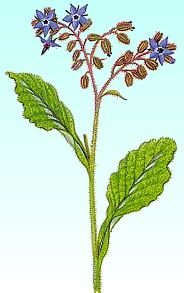 Today, April 14th …
Today, April 14th …Well, we really need to get a whole cuisine, and a few centuries away from yesterday’s traumatic topic. Some readers have not yet found their appetites restored.
Luckily, today is St Lidwina’s day (which I am sure you know) and the plant dedicated to her is borage (Borago officinalis), a most versatile but underused herb, and one which will serve for today’s lesson – that there are a lot of Good Ideas in The Past waiting to be rediscovered and presented as Innovative Modern Recipes.
Firstly, its Food Porn attributes: it is prettily hirsute with bright blue flowers, and it smells like cucumbers, or like the freshness that the smell of cucumbers imparts.
Secondly, its medicinal reputation. To quote the historical authorities: Gerard (1597) says it will “exhilerate and make the mind glad”, Evelyn (1664) that it “revives the hypochrondriac and cheer the hard student”, Parkinson (1640) that it “expels pensiveness and melanchollie”, and Culpeper (1653) that it is useful in “putrid and pestilential fever”. As for modern authorities, there is some evidence that borage oil may benefit people with eczema: The Old Foodie will watch the journals.
Now the culinary aspects. The young leaves, tops and flowers can be used in salads, or the whole plant cooked as a pot-herb, steeped in wine, or made into a flavouring syrup. The flowers make wonderful honey (hence its nickname of ‘bee-bread’) and also used to be candied as a sweetmeat. How useful is that?
To demonstrate a Good Idea from The Past, here is a very interesting salad recipe from England’s oldest ‘cookbook’ – a manuscript called “The forme of cury, a roll of ancient English cookery, compiled, about A.D. 1390, by the master-cooks of King Richard II”
Salat.
Take parsel, sawge, garlec, chibollas, onyons, leek, borage, myntes, porrectes [porette], fenel, and ton tressis [cresses], rew, rosemarye, purslarye [purslain], lave, and waishe hem clene; pike hem, pluk hem small with thyn honde, and myng [mix] hem well with raw oile. Lay on vynegar and salt, and serve it forth.
Or if you prefer a restorative broth (‘eowtes’ means a sort of pottage):
Eowtes of Flesh.
Take borage, cool [colewort], lang-debef [bugloss], persel [parsely], betes [beet-root] orage [orach] auance [avens], violet, sawray [savory] and fenkel [fennel], and when they buth [are] sodden, presse hem wel smale, cast hem in gode broth, and seethe hem, and serve hem forth.
On Monday: Celebrating Eliza.
4 comments:
oh am i glad i stumbled upon here, and i shall be back again.
cheers.
Hello mayamaya
Glad you stumbled in, and glad you shall be back. I'll keep an eye on your blog too!
What a wonderful blog! I, too, am so glad that I found this. How unique, informative and entertaining. I've subscribed and am looking forward to new posts.
Happy Easter!
Sally
Hello Sally
Thankyou for visiting and enjoying. There will be a post each weekday, as promised. I've since visited you too - I love the latest shrimp recipe - we call them prawns here in Aus. The shellfish is great here in Queensland,so I am always on the lookout for recipes for them. If I post a historic recipe using them, I'll send you a special notice by email!
Post a Comment